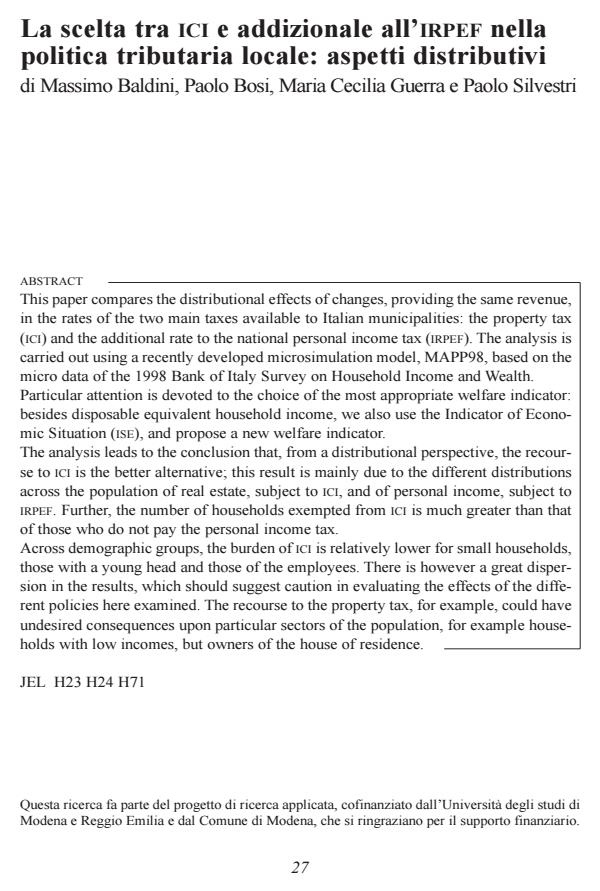La scelta tra ICI e addizionale all'IRPEF nella politica tributaria locale: aspetti distributivi
Titolo Rivista ECONOMIA PUBBLICA
Autori/Curatori Massimo Baldini, Paolo Bosi, Maria Cecilia Guerra, Paolo Silvestri
Anno di pubblicazione 2001 Fascicolo 2001/2 Lingua Italiano
Numero pagine 37 P. Dimensione file 1696 KB
DOI
Il DOI è il codice a barre della proprietà intellettuale: per saperne di più
clicca qui
Qui sotto puoi vedere in anteprima la prima pagina di questo articolo.
Se questo articolo ti interessa, lo puoi acquistare (e scaricare in formato pdf) seguendo le facili indicazioni per acquistare il download credit. Acquista Download Credits per scaricare questo Articolo in formato PDF

FrancoAngeli è membro della Publishers International Linking Association, Inc (PILA)associazione indipendente e non profit per facilitare (attraverso i servizi tecnologici implementati da CrossRef.org) l’accesso degli studiosi ai contenuti digitali nelle pubblicazioni professionali e scientifiche
This paper compares the distributional effects of changes, providing the same revenue, in the rates of the two main taxes available to Italian municipalities: the property tax (ICI) and the additional rate to the national personal income tax (IRPEF). The analysis is carried out using a recently developed microsimulation model, MAPP98, based on the micro data of the 1998 Bank of Italy Survey on Household Income and Wealth. Particular attention is devoted to the choice of the most appropriate welfare indicator: besides disposable equivalent household income, we also use the Indicator of Economic Situation (ISE), and propose a new welfare indicator. The analysis leads to the conclusion that, from a distributional perspective, the recourse to ICI is the better alternative; this result is mainly due to the different distributions across the population of real estate, subject to ICI, and of personal income, subject to IRPEF. Further, the number of households exempted from ICI is much greater than that of those who do not pay the personal income tax. Across demographic groups, the burden of ICI is relatively lower for small households, those with a young head and those of the employees. There is however a great dispersion in the results, which should suggest caution in evaluating the effects of the different policies here examined. The recourse to the property tax, for example, could have undesired consequences upon particular sectors of the population, for example house-holds with low incomes, but owners of the house of residence.;
Massimo Baldini, Paolo Bosi, Maria Cecilia Guerra, Paolo Silvestri, La scelta tra ICI e addizionale all'IRPEF nella politica tributaria locale: aspetti distributivi in "ECONOMIA PUBBLICA " 2/2001, pp , DOI: